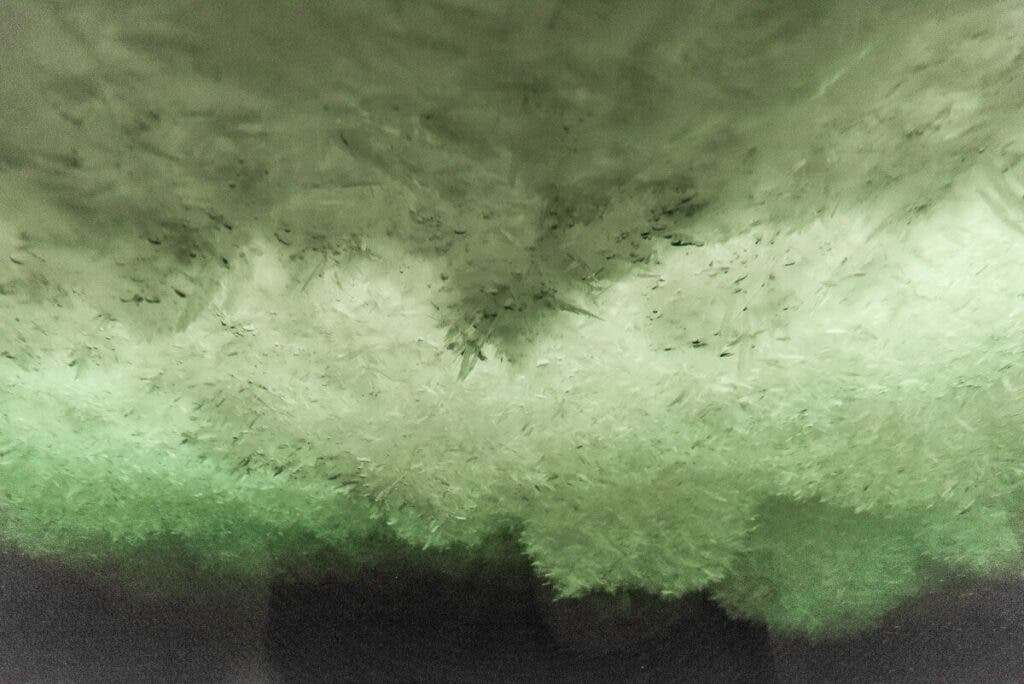
Below Europa‘s thick icy crust lies a vast, global, and liquid ocean. Understandably, researchers are very interested in that liquid ocean since where there’s liquid water, there could also be life.
A new study has found that this massive body of water most likely contains “frazil ice,” a layer of ice formed when snow floats upwards onto inverted ice peaks and submerged ravines. The bizarre type of underwater snow is known to occur beneath ice shelves on Earth, but a new study indicates that it may also contribute to the formation of Jupiter’s moon’s icy shell. The result of this ice could be better research results for NASA’s Europa Clipper.
This type of underwater ice is basically like upside-down snow — where congelation ice (another type of ice) grows from beneath the ice shelf itself, frazil ice drifts through superchilled water in flakes and then ultimately settles on an ice shelf, like snowflakes falling down on the ground, except this time it’s ice that drifts in the water before settling down on the frozen surface.
This type of ice is significantly purer than other types of ice, suggesting that Europa’s ice shell may be significantly less salty than previously believed. This is essential for mission scientists preparing NASA’s Europa Clipper spacecraft, using radar to peer beneath Europa’s ice shell to determine whether its ocean could support life. Salt trapped in the ice can affect what and how deeply the radar can see into the ice shell, so being able to predict the composition of the ice will assist scientists in making sense of the data.
“When we’re exploring Europa, we’re interested in the salinity and composition of the ocean, because that’s one of the things that will govern its potential habitability or even the type of life that might live there,” said the study’s lead author Natalie Wolfenbarger, a graduate student researcher at the University of Texas Institute for Geophysics (UTIG) in the UT Jackson School of Geosciences.
Icy waters
The study was led by researchers from the University of Texas at Austin, which also leads the development of the ice-penetrating radar instrument for Europa Clipper. Determining the salinity and habitability of Europa’s ocean requires knowledge of Europa’s ice shell, which is where the Clipper mission is expected to provide a lot of useful information. It was based on observations made on Earth in conditions that researchers would also expect to see on Europa, and was published in the journal Astrobiology. Previous research indicates that the temperature, pressure and salinity of Europa’s ocean closest to the ice are comparable to those found beneath an Antarctic ice shelf.
Armed with this information, the new study used Antarctica’s ice shelves to research its two primary types of ice: congelation ice, which forms immediately beneath the ice shelf, and frazil ice.
Both methods produce ice that is less salty than seawater, and Wolfenbarger discovered that the ice shell of Europa would be even less salty when scaled up to its size and age. Moreover, according to her calculations, frazil ice, which retains only 0.1% of the salt in seawater, is extremely prevalent on Europa. This works in the favor of the Europa Clipper since congelation ice might contain as much as 10% of the salt of the surrounding seawater. Thus, an ice shell formed by frazil ice may be purer by orders of magnitude than previously estimated. This impacts its strength, how heat moves through it and the forces that may drive a type of ice tectonics.
In the eyes of astrobiologists, Europa is one of the solar system’s most fascinating worlds. According to NASA, there is an ocean covering the moon with a depth of between 40 to 100 miles (60 – 150 km), and this ocean is covered by an ice crust that is between 10 and 15 miles (15 – 25 km) thick. Europa is a fascinating place to look for alien life because while the satellite is only a quarter the size of Earth (roughly the size of our moon), its surface-wide ocean may hold about twice as much water as all of Earth’s oceans.
“This paper is opening up a whole new batch of possibilities for thinking about ocean worlds and how they work,” said Steve Vance, a research scientist at NASA’s Jet Propulsion Laboratory (JPL) who was not involved in the study. “It sets the stage for how we might prepare for Europa Clipper’s analysis of the ice.”









